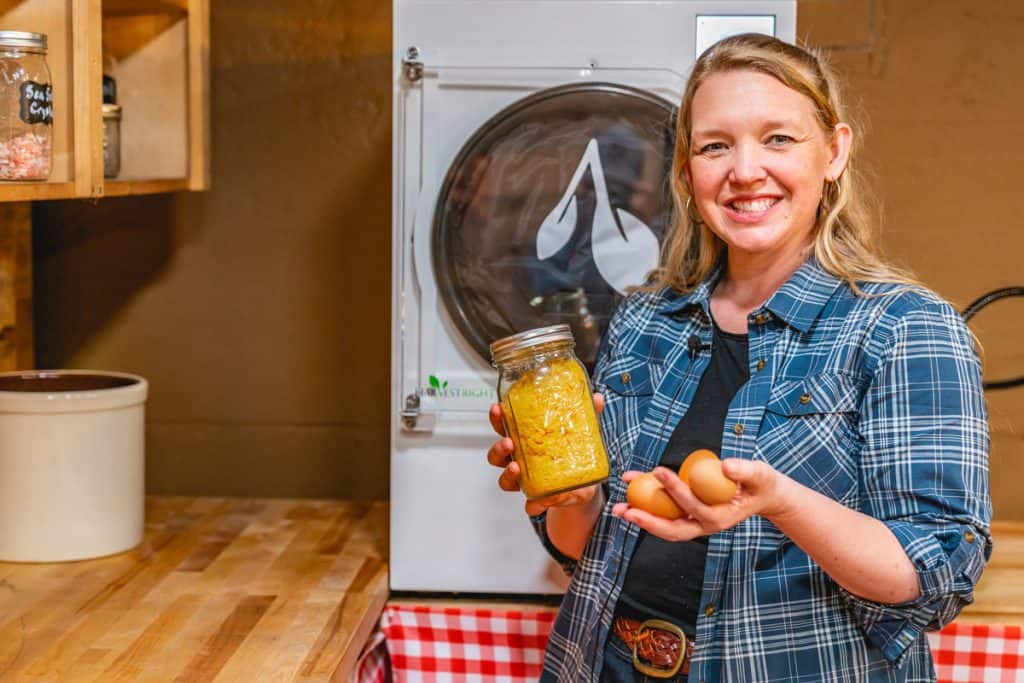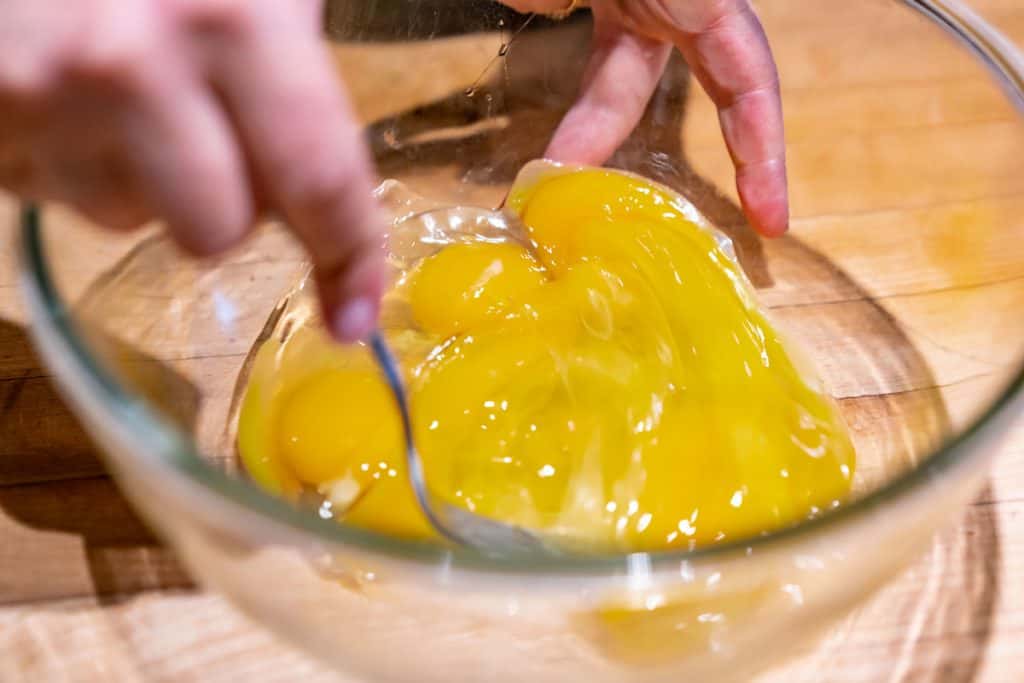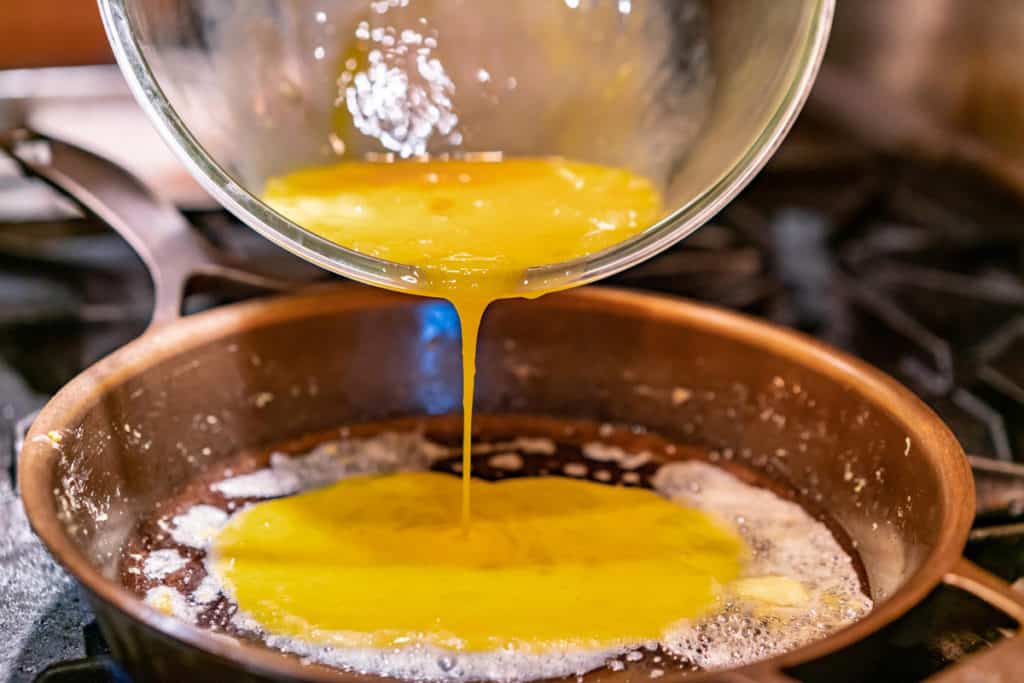









Knowing all the methods for preserving farm-fresh eggs is important if you’re raising backyard chickens. We’re excited to share this new method we’re loving, it’s freeze dried eggs that will last on your shelf for 20+ years!

I love getting a lot of farm fresh eggs in the spring and summer months and preserving them to use when our chickens slow down in the winter.
But not all egg preservation methods keep your eggs safe for long-term storage. In fact, water-glassing eggs is probably the longest, keeping eggs fresh for about 12-18 months.
Freezing eggs is also great, but it can start to take up a lot of freezer space and after about 3 months the texture begins to change a bit.
The other egg preservation methods such as pickled eggs or making homemade egg noodles are fantastic, but you don’t then have the option of using them as fresh eggs for scrambling or using in baked goods.
Preserving with a Freeze Dryer
You all know by now that we’re big advocates of building up a well-stocked pantry and having a long-term food-storage supply. This is why we’re so excited to finally have our own freezedryer to help expand our preservation methods!
We enjoy freeze dried corn, freeze dried milk, freeze dried coffee, freeze dried meat, and even make freeze dried homemade dog food.
Of course, we’ll still do our fair share of water-bath and pressure canning. And we can’t live without our beloved fermented foods either.
But the great thing about preserving eggs in the freeze dryer is that it’s very, very simple with little hands-on time!

Freeze drying also preserves the nutritional value of the eggs better than any other method, especially when we’re talking about the outer limits of the food preservation range.
In this case, your eggs will retain their nutritional value for up to 25 years of storage. That’s pretty amazing!
We’ve been very pleased with our Harvest Right Freeze Dryer and we’ll continue to share tutorials like this as we use it for more preservation methods. (Read our Harvest Right Freeze Dryer 1 year review and 10 reasons we love freeze drying.)
How to Freeze Dry Eggs
- Crack and scramble
- Pre-freeze in trays provided
- Freeze dry
- Check
- Store

Crack and Scramble Eggs
Crack 12-18 eggs in a large bowl. I’ve found this is the most I can safely fit per Harvest Right freeze dryer tray (without the risk of spilling eggs all over the floor!).
Beat the eggs well with a fork or immersion blender then pour onto the freeze drying tray.
Pre-Freeze
Carefully transfer your freeze drying tray to the freezer (not the freeze dryer) and let them pre-freeze for about 2-3 hours, or until they’re frozen solid.

Freeze Drying Eggs
Once your eggs are frozen, but before you remove them from the freezer, you’ll want to pre-cool your freeze dryer. To do this follow these simple steps:
- Be sure your freezer dryer is on.
- Hit the start button.
- Press “pre-frozen” because we’ve already frozen our eggs.
- Allow the freeze dryer to cool to 32 degrees F. This takes about 20-30 minutes.
- Once the screen says, “Load Food into Freeze Dryer…CLOSE DRAIN VALVE”, make sure the drain valve is closed, then open the door and load your trays into the freeze dryer.
- Add the insulator over the doorway then close and lock the door.
- Your eggs will be done in roughly 24 hours depending on the number of eggs you’re drying.
How to Know When Eggs Are Done
Once the freeze dryer gives you the signal that your food is complete, go ahead and pull out each tray and inspect the food to ensure it’s actually dry all the way through.
To do this with a tray of eggs, you’ll want to take a spoon or fork and scoop up the eggs from the center of the tray. Using your hands, press and squeeze the eggs to be sure there’s no liquid remaining.
The eggs should not feel frozen at all and should crumble into a powder if they’re done.
If for any reason the eggs don’t seem done, you’ll want to place them back into the freeze dryer and hit the “more time” button.
Package and store the eggs as soon as they come out of the freeze dryer. Don’t let them sit out in the open for very long because they will suck up any moisture or humidity from the air.

How to Store Freeze Dried Eggs
There are a few different methods for storing freeze dried eggs.
- Mason Jar – If you’re going to use the eggs right away, or within a few weeks, you can simply scoop the powder into a mason jar and place a plastic lid on top.
- Vacuum-Sealed Jar – If your eggs are going to sit for longer than a few weeks, you’ll want to use the two-part mason jar canning lids and vacuum seal the jar shut.
- Oxygen Absorber – By adding an oxygen absorber into the jar, this will help eliminate any possible moisture, so I highly recommend using them. (I like to buy these in bulk from Azure Standard.) Homesteading Hack: If you’re a first-time Azure Standard customer, use coupon code “HOMESTEADINGFAMILY15” at checkout for 15% off your order of $100 or more!
- Mylar Storage Bags – A great way to store freeze dried eggs for taking on backpacking, hunting, or camping trips is to measure out and store them in Mylar bags. These will help keep out any moisture, and you will need to toss in an oxygen absorber.
- Vacuum Sealed Bags – You can also use a vacuum sealer and store freeze dried eggs this way. We don’t love the idea of using a lot of plastic in our home, so we opt for vacuum sealing our mason jars instead.

How to Use Freeze Dried Eggs
Using freeze dried or powdered eggs couldn’t be easier. Simply mix two tablespoons of your freeze dried eggs with two tablespoons of cold water into a bowl or a jar, stir together and let sit for two minutes to allow the water to be fully absorbed.
Cook them up the same way you’d cook up scrambled eggs (we like scrambling our eggs in a cast iron skillet, especially over an open fire when camping) or use the rehydrated eggs as you would a fresh cracked egg in baking or delicious bacon frittata.

Maximizing Your Freeze Dryer
Have you ever wondered what else you can preserve with a freeze dryer?
I reveal the answer to this and so much more in my book Freeze Drying the Harvest: Preserving Food the Modern Way and my Freeze Drying Masterclass. From wild game to watermelon and milk to mashed potatoes — you’ll learn the ins and outs of preserving more food than you thought possible.
These resources can be purchased separately or as companions, so whether you choose the book or the masterclass, you will receive all the information you need to gain the confidence and skills you need to preserve meat, eggs, veggies, fruit, herbs — and yes, even lattes!
FAQs
Why do I have to pre-freeze the eggs?
You may be wondering why we pre-freeze the eggs before putting them into the freeze dryer.
When you turn on the Harvest Right freeze dryer, it actually turns on a vacuum pump. Once you close the door to your freeze dryer, after adding your trays, it creates a vacuum so quickly that it can actually splash the liquid all over the machine and cause a cleaning nightmare.
So you want to be sure to pre-freeze anything liquid when you’re freeze drying.

How do I know when the eggs are done?
You’ll know your eggs are completely freeze dried when you take them out of the freeze dryer and they crumble to a powder when scooped up with a spoon.
When you touch the freeze dried eggs, they shouldn’t feel cold or frozen, if you feel this, that means there’s still moisture in them and you need to add them back to the freeze dryer to continue drying (use the “more time” button for this).
What can I use freeze dried eggs for?
You can use freeze dried eggs for anything you would use a fresh cracked beaten egg. This could be for baked goods, scrambled eggs, an egg-wash, and so much more!
How much nutrition is lost with freeze drying?
Freeze drying food retains “97 percent of its nutrition because of the cold vacuum process that is used to extract the water. Freeze drying doesn’t change the look or the taste of the food.” (Source)
That means for up to 25 years, you’ll be getting 97% of the nutritional value of a farm-fresh egg, cracked straight from the henhouse!
That’s pretty fantastic! If you’re looking to increase your food preservation methods, a Harvest Right Freeze Dryer is one purchase you really should consider.


















